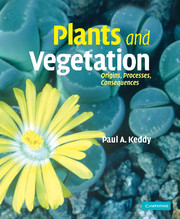Book contents
- Frontmatter
- Contents
- Preface
- Acknowledgements
- Chapter 1 Plants and the origin of the biosphere
- Chapter 2 Description of vegetation: the search for global patterns
- Chapter 3 Resources
- Chapter 4 Stress
- Chapter 5 Competition
- Chapter 6 Disturbance
- Chapter 7 Herbivory
- Chapter 8 Positive interactions: mutualism, commensalism, and symbiosis
- Chapter 9 Time
- Chapter 10 Gradients and plant communities: description at local scales
- Chapter 11 Diversity
- Chapter 12 Conservation and management
- Questions for Review
- References
- Index
- References
Chapter 4 - Stress
- Frontmatter
- Contents
- Preface
- Acknowledgements
- Chapter 1 Plants and the origin of the biosphere
- Chapter 2 Description of vegetation: the search for global patterns
- Chapter 3 Resources
- Chapter 4 Stress
- Chapter 5 Competition
- Chapter 6 Disturbance
- Chapter 7 Herbivory
- Chapter 8 Positive interactions: mutualism, commensalism, and symbiosis
- Chapter 9 Time
- Chapter 10 Gradients and plant communities: description at local scales
- Chapter 11 Diversity
- Chapter 12 Conservation and management
- Questions for Review
- References
- Index
- References
Summary
Definitions. Avoidance and tolerance. Stress as a metabolic cost. Measurement of stress in experiments. Evolution in stressed habitats. Plant traits and stress (low growth rate, seed size, clonal integration). Drought: deserts, Mediterranean shrublands (maquis, kwongan, fynbos), rock barrens (rock domes, tepui, alvars, serpentine), conifer forests. Resource unavailability (peat bogs). Regulators: salt marshes and mangal, Arctic and alpine plants, early spring leaves. Extremes: lichens on and in rocks, wetland plants. Acid precipitation in the Smoking Hills. Radiation. The issue of scale.
Introduction
Definitions
Resources such as C, H, N, O, P, and S are essential for the construction of new plant tissues. We have just seen in Chapter 3 that habitats with a chronic scarcity of such resources tend to have plants that differ from those in habitats in which resources are more freely available. Shortages of resources will tend to reduce rates of growth, thereby reducing attributes such as shoot size, root length, and allocation to flowers and seeds (Levitt 1980, Grime 1979, Larcher 2003). Stress is therefore defined as any factor that reduces the rate of production of biomass. It is important to understand that stress is different from disturbance, because disturbance, as we shall see in Chapter 6, removes only biomass that has already been produced.
Like any word, the term stress can be used carelessly. Too often, as Harper (1982) observes, it has meant “little more than the observer judging what I don't think I'd like if I was a buttercup, kangaroo, flea, beetle, etc.”
- Type
- Chapter
- Information
- Plants and VegetationOrigins, Processes, Consequences, pp. 126 - 185Publisher: Cambridge University PressPrint publication year: 2007



